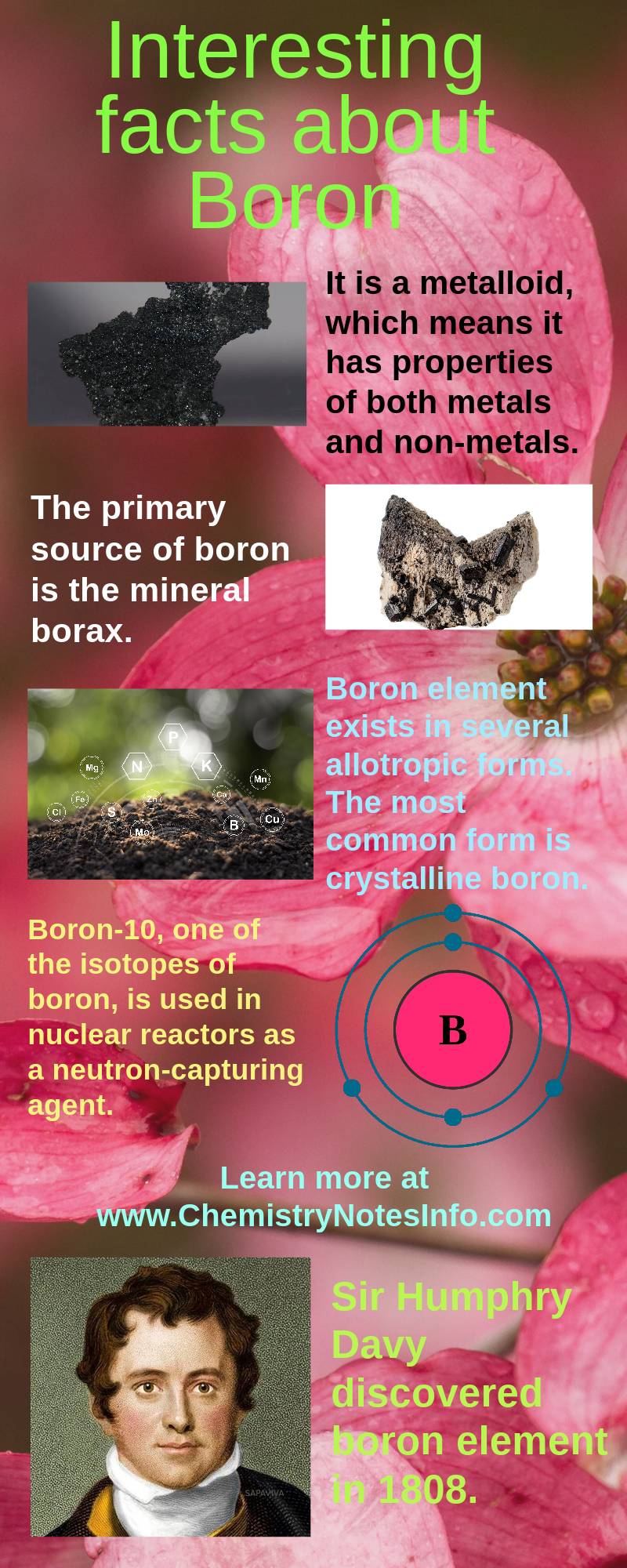Top 10 interesting facts about Boron Element
Dear friends in this post we learn about top 10 interesting facts about boron element. Boron is very important element in periodic table of elements. It is used from historical times in very scientific and industrial applications.
 |
| Top 10 interesting facts about Boron Element |
- Elemental Identity: Boron element is a chemical element in periodic table of elements with the symbol "B" and atomic number 5. It is a metalloid, which means it has properties of both metals and non-metals.
- Abundance in Earth's Crust: Boron element is relatively rare in Earth's crust compared to other elements, making up about 0.001 percent by weight. The primary source of boron is the mineral borax.
- Discovery and Naming: Sir Humphry Davy discovered boron element in 1808. The name of this newly discovered element "boron" is derived from the Arabic word "Buraq" which refers to borax.
- Allotropic Forms: Boron element exists in several allotropic forms. The most common form is crystalline boron, which has a black, metallic appearance. Amorphous boron is another form with a brown powder-like appearance.
- Use in Nuclear Reactions: Boron is also known for its ability to absorb neutrons. Boron-10, one of the isotopes of boron, is used in nuclear reactors as a neutron-capturing agent, which is helping in control of nuclear reactions.
- Borates and Borax: Boron compounds, particularly borates and borax, have been used for centuries in various applications. Borax, a salt of boric acid, has been historically used for cleaning, preserving wood, and even as a food preservative.
- Flame Retardant Properties: Boron compounds are utilized as flame retardants in the manufacturing of certain materials, including textiles and plastics. Boron compounds work by inhibiting the combustion process. Hence, boron is used in fire and safety departments.
- Role in Plant Growth: Boron is an essential micronutrient for plant growth. It plays a crucial role in cell wall formation. It is also involved in various physiological processes in plants.
- Boranes and Boron Hydrides: Boron forms a class of compounds known as boranes and boron hydrides. These compounds have interesting structures and find applications in the field of organic and inorganic chemistry.
- Potential Medical Applications: Boron compounds are being researched for potential medical applications, including cancer treatment. Boron Neutron Capture Therapy (BNCT) is a technique that uses boron to selectively destroy cancer cells with neutron irradiation.
Infographics on Interesting Facts about Boron
Physical and Chemical Properties of Boron
Physical Property | Value/Description |
Symbol | B |
Atomic Number | 5 |
Atomic Mass | 10.81 u |
Density | 2.34 g/cm³ |
Melting Point | 2,300°C (4,172°F) |
Boiling Point | 2,550°C (4,622°F) |
State at Room Temperature | Solid |
Color | Brown (amorphous) or Black (crystalline) |
Crystal Structure | Rhombohedral |
Electronegativity | 2.04 (Pauling scale) |
Specific Heat Capacity | 1.026 J/g°C |
Given below are the chemical properties of Boron element.
Chemical Property | Value/Description |
Electron Configuration | 1s² 2s² 2p¹ |
Common Oxidation States | 3 |
Common Compounds | Borax (Na2B4O7·10H2O), Boric Acid (H3BO3) |
Natural Abundance | Relatively low (0.001% of Earth's crust by weight) |
Uses | Nuclear reactors, Flame retardants, Agriculture (as a micronutrient), Boron Neutron Capture Therapy (medical applications) |
If you like our science facts on Hydrogen Helium Lithium Beryllium Boron, then share with your friends at WhatsApp Facebook and other social media platforms.




.jpg)
%20(1).png)
